If you have plans to have a China tour with Yangtze River cruise 2022, this itinerary is the one you can take a close look at. This 11 days China tours 2022 will bring you to the so called Golden Triangle cities, Beijing Xi’an and Shanghai, which are the most popular destinations in China among tourists. And you will visit the world renowned tourist attractions like the Great Wall, Forbidden City, Terra Cotta Warriors and Horses Museum, the Bund, and Yu Garden. Besides these cities, you will take a Yangtze River cruise along the magnificent Yangtze River, where you can marvel at the beauty of the Three Gorges. What are you waiting for? You are just one click away from this China tour with Yangtze River cruise 2022.

Welcome to Beijing which is set as our first destination of the 11-day China tour 2022. A pick-up service is included for you once you arrive at the airport, and then you will be sent to the hotel for a rest.
Beijing is a megacity that serves as the capital of China and is home to 7 UNESCO world heritage sites. It is a perfect combination of a slew of ancient and historical sites as well as modern and vibrant entertainments. It must be the essential stop on the traveling list for anyone coming to China. And we have planned a nice itinerary to help you make the most out of your time.
We have made your first stop in Tian’anmen Square after breakfast. Tian’anmen Square is the world’s biggest public square covering the area equating with 62 soccer fields (about 44 hectares). Located in the very heart of Beijing city, the area of the square was once exclusively used by the imperial family. It functioned as a place of issuing an “imperial edict” of national events such as the enthronement of the emperors or the coronation of the empresses. Tian’anmen has witnessed the ups and downs of the Chinese nation, playing an iconic role among Chinese people. Therefore, it is included as a part of the Chinese National Emblem.
Our next destination is the Forbidden City (closed every Monday). The Forbidden City was firstly built in 1406 and served as the home of 24 emperors spanning over 500 years, representing the best-preserved imperial palace complex in China and top of the five greatest palaces in the world. As its name is with a “city”, you can imagine how grand it is. The folklore says that the Forbidden City houses 9,999.5 rooms to show the power of the emperor yet respecting the Heavenly Palace where the Jade Emperor lives according to Chinese legends (It is said that there are 10,000 rooms in the Heavenly Palace, so building half a room less than that shows respect to the Heavenly Palace, and in the meantime, representing the “second only to the Heavenly Palace” power of the emperor.). But the fact is there are indeed about 8,700 rooms here, covering 720,000 square meters which is equivalent to 437 White House. The Forbidden City is divided into the Outer Court for the emperor dealing with political affairs, and the Inner Court for the daily life of the emperor with his family. As a UNESCO World Heritage Site, the Forbidden City would give a crash course on Chinese culture and history to you.
Our morning tour ends and lunch is prepared for you. The afternoon tour begins with the Temple of Heaven. The Temple of Heaven was originally constructed in 1420, the same time as the Forbidden City, and it is four times larger than the Forbidden City. It was the temple complex that provided a place for the emperors to pray for a good harvest. The Temple of Heaven includes the Circular Mound Altar, the Imperial Vault of Heaven, and the Hall of Prayer for Good Harvests, among which the last one is one of the iconic images of Beijing. The Echo Wall and Three Echo Stones are also worth visiting. Both of them make use of the unique acoustic properties of some materials, the former was designed in a fashion that a whisper can be able to travel from one end to the other. And the latter one was designed to boost the speakers’ voice over 9 times. The Temple of Heaven now serves as a tranquil hangout for the locals.
Then we will continue our trip to another UNESCO World Heritage Site, the Summer Palace. The Summer Palace is the best-preserved and the largest imperial garden in China. In 1750, the Summer Palace was built to celebrate the birthday of Emperor Qianlong’s mother. And it was later exclusively used as the summer residence for the imperial family. A stunning feature of the palace lies in the man-made Kunming Lake with three islands connected by exquisite stone bridges. The 17-Arch Bridge is the biggest stone bridge in the palace. The 150-meter-long bridge, with carved lions mounted on the columns, has delighted numerous sightseers and photographers because of the scene it creates. The design of the bridge can allow sunlight to pass through its 17 arches, displaying a spectacular scene. That is the end of our second day’s trip in Beijing! Our guide will send you to the hotel.
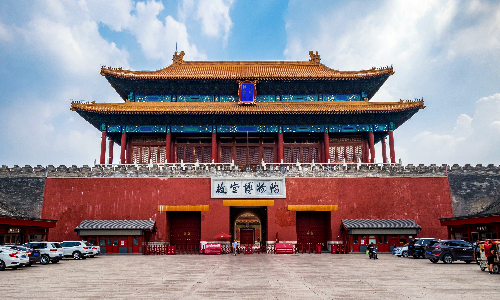
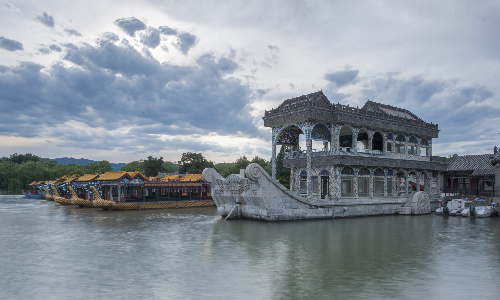
After your breakfast, our guide will pick you up and take you to Sacred Way and Chang Tomb of the Ming Tombs after breakfast. The drive will take about one and a half hours (about 53 kilometers) by car heading to the northwest.
The Sacred Way is a road leading to the Ming Tombs, the cemetery of 13 emperors of the Ming Dynasty (1368-1644). In ancient China, the emperor was regarded as the Son of Heaven, and the Sacred Way was built symbolizing the way leading to heaven. The way along the marble path was lined with willows and marble statues of officials, guardian animals, and mythical animals in large-than-life size.
Then you will visit the Chang Tomb of Ming Tombs. Chang Tomb buried the third emperor of the Ming Dynasty, Emperor Yongle, and his wife Xu. It is also the grandest, and definitely the best-preserved one among 13 tombs. Constructed in 1409 and finished in 1413, the Chang Tomb mainly includes the underground palace, a memorial tower, a huge citadel, and a gigantic bronze statue of Emperor Yongle himself. Any excavation in the area is forbidden so the underground palace is not yet discovered, and no one knows the exact spot the emperor is buried, remaining a mystery to all. This place has greeted several foreign celebrities such as Queen Elizabeth II and her husband Prince Philip.
After lunch, your guide will take you further east to the Badaling Great Wall. It is about 36 kilometers away, and it takes around 50 minutes. The Great Wall is honored as the seventh wonder of the world. It was a military project in ancient China with a length of more than 20,000 kilometers, and spanning two thousand years. The most representative section of the Great wall is the Badaling Great Wall. Constructed in 1505, Badaling Great Wall was made of large bricks and was wide enough for ten soldiers marching side by side. “Bada” refers to “giving access to all directions” in Chinese, so its name itself manifested the militarily strategic importance of the section. With the highest point of the section reaching 731 meters above sea level, climbing to its top is not an easy task. China hence has a saying that “one who failed to reach the top of the Great Wall is not a hero”. The view you will see on the top, however, is rewarding. This section enjoys the awe-inspiring scenery that the wall winds its way along the contour of mountains until finally merged with the distant haze. Of course, cable cars are also provided if you are not willing to hike. This will be the end of your tour in Beijing! We will send you to the hotel afterward.
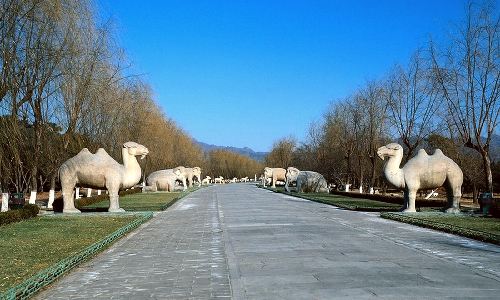
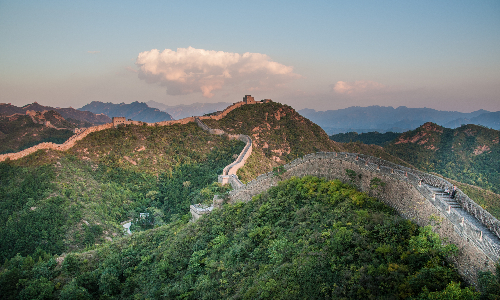
 Xi’an
Xi’an After breakfast, our guide will drive you to the railway station to take the estimated train G571 09:22/15:07 to Xi’an. Lunch is offered during the trip. Upon arrival at Xi’an, you will be picked up and transferred to the hotel.
Together with Athens, Rome, and Cairo, Xi’an is honored as one of four capitals of ancient civilizations in the world. As the first capital of united China in 221 BC and ruled by 13 dynasties. It can say that Xi’an represents the birthplace of the nation of China in many ways, serving as a superb window to appreciate ancient China.
It is not only the home of Terra Cotta Warriors and Horses but also the starting point of the ancient Silk Road. Spanning over 3,100 years, Xi’an boasted a myriad of relics and attractions. Every inch of ground you stepped probably buried lots of valuable antiquities.
When speaking of Xi’an, how can we miss the world-renowned Terra Cotta Warriors and Horses? Yes, our first stop will be the Terra Cotta Warriors and Horses Museum. After breakfast, we will drive to the northeast from downtown for about 50 minutes (about 40 kilometers). The Terra Cotta Warriors and Horses Museum mainly displays the terra cotta figures of more than 2,000 years old. These figures were built under the supervision of the first emperor in China, Emperor Qin Shihuang, and stood as garrison force to protect the emperor’s mausoleum. The terra cotta warriors and horses are collectively known as the “Eighth Wonder of the World”. The discovery of them was on account of local farmers who discovered broken pieces of terra cotta warriors when digging a well. The archaeological team quickly followed up to make a further excavation, and finally unearthed 3 pits of the terra cotta warriors and horses as well as other numerous burial objects. And that shocked the world and was praised as “one of the greatest archaeological discoveries of the twentieth century”. The terra cotta warriors and horses are all life-sized, and some of the warriors are equipped with real bronze battle weapons. Orderly arrayed in rows, these figures made up a great underground army consisting of infantrymen, cavalrymen, other armed servicemen, and chariots. Only when you're there will you know how impressive it is, and this is a must-see place on your visit list to China. After your visit here, we will take you to a local restaurant to have lunch.
Afterward, you will visit Small Wild Goose Pagoda. The Small Wild Goose Pagoda (closed each Tuesday) was originally built in 707 AD for storing the Buddhist scriptures brought back by Monk Yi Jing (an eminent monk in the Tang Dynasty) from Tianzhu (the ancient name of India) during the Tang Dynasty (618-907). With 13 stories and a height of about 43 meters, the pagoda was once called “Jianfu Temple Pagoda”, meaning a pagoda in the temple that offers happiness. As for its present name, it closely relates to the Big Wild Goose Pagoda which was constructed earlier than the small one to store the Buddhist scriptures that Monk Xuanzang (another great monk in the Tang Dynasty) brought from India. Both of the pagodas are shaped like a rectangular pyramid and they share the same function to store scriptures, so later people call the latter-built pagoda “Small Wild Goose Pagoda”. It is said that the Small Wild Goose Pagoda cracked three times because of earthquakes but then magically recovered by itself. But the fact is that the pagoda indeed has remained relatively intact except for some damage on the top two floors due to storms and earthquakes.
The trip continues to the ancient City Wall. The wall is 637 years old. It is 12 meters in height and about 15 meters in width. The 14-kilometer-long wall is the oldest and the most complete ancient city wall in China. It once served as a defense system and is now a famous tourist attraction. The wall was built in the Ming Dynasty (1368-1644) and was equipped with a moat, intricate towers, and drawbridges to safeguard the city and the people. This wall separates Xi’an into the inner city area and outer city area. The inner city area is mostly occupied by ancient and low-rise buildings, while the outer city area has lots of modern high-rise buildings. When walking on top of the City Wall, you will find the difference between the two areas interesting. This is also a place that many foreign celebrities would visit. The former U.S. First Lady Michelle Obama once visited here during her China tour in 2014. Another highlight of the wall is the annual Xi'an City Wall International Marathon starting from the year 1993, and thousands of local and overseas athletes gather to compete on a special track, the wall, on every first Sunday in November.
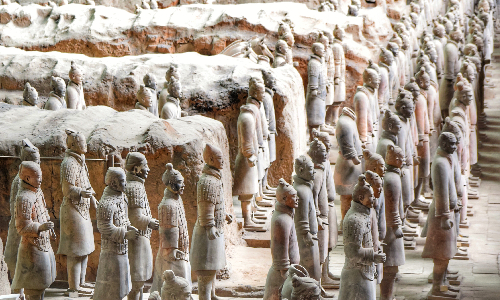
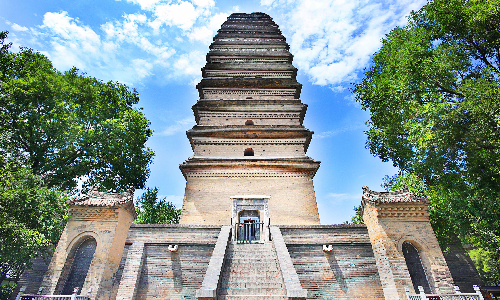
 Chongqing
Chongqing Yangtze River Cruise
Yangtze River Cruise Time flies to the sixth day, and our guide will send you to the train station to take the estimated train D1971 09:05/13:42 to Chongqing after breakfast. Upon arrival, your guide will first take you to a tourist attraction called Hongya Cave in Chongqing. Chongqing is a mountain city, and Hongya Cave is the most representative structure on the mountain. It is a perfect place to spend some leisure time. Here, you can go around to do some shopping, sit in a cafe to relax, or climb up to the top floor to marvel at the beauty of the nearby Jialing River. After some free time here, your guide will escort you to the Chaotianmen Dock to board the cruise ship to start your Yangtze River cruise tour. Your guide will help you with checking in on the ship. Your cruise ship is scheduled to set off at about 9 pm.
The cruise ship sails downstream along the Yangtze River, which is the best way to discover the spectacular river scenery. The river curved its way through rocky walls and sneaked back and forth through lush forests. Many historical and cultural sites stand along the banks of the river. Different types of cruise ships may offer different entertainment facilities with slightly different sightseeing routes. But the service they provide is equally professional. Onboard, you can join your fellow guests in the bars to enjoy the elegant landscape on both sides. Or you can read books, watch movies, swim in the pool or even play golf. Parties, culture shows and Tai Chi exercises are also offered. Moreover, with a broad spectrum of options to suit all dietary requirements, vegetarians or vegans can also enjoy agreeable meals.
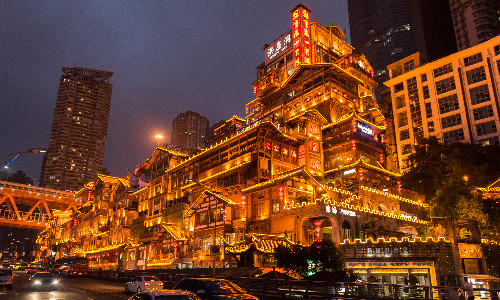
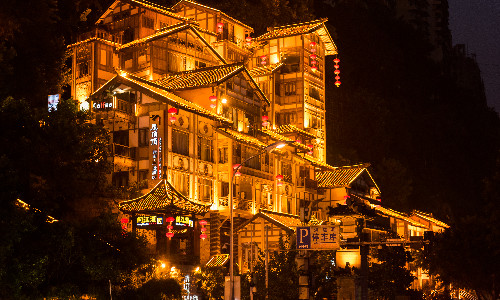
On the 7th day, you can start your morning with a cup of coffee/tea, join a Tai Chi exercise with the certified instructor, or simply stay in bed to fuel up. And the buffet breakfast will greet you before we have a shore excursion to Fengdu "Jade Emperor" scenic area.
Located on the northern bank of the Yangtze River, Fengdu “Jade Emperor” scenic area is a theme park based on Chinese Taoist mythologies. “Jade Emperor” was regarded as the supreme god who governs the Heaven. This area has the world’s largest statue of the Jade Emperor, reaching about 33 meters high, equivalent to a 10-story building. An interesting fact is that the statue was once selected as one of the ten ugliest constructions in China, so it went through several times of large-scale restorations. Besides this giant statue, now there are more than 200 refined sculptures in this park. The park aims to promote the religious philosophy and culture of Taoism. If you are interested in Taoism, this is a must-see spot for you.
An optional tour you can choose is the visit to Fengdu Ghost City. Note that extra charges are needed. Fengdu Ghost City is regarded as a place dedicated to the underworld. It is a small village that boasts temples displaying instruments of punishment for the sin spirit, shrines, and ghoulish-looking statues. This city may represent the closest to the “Gothic” style you can see in China. As one of the most popular sites during the Yangtze River cruise, the city has more than 2,000 years of history. It was believed that this is a sinner-beware place because the evil spirits would fail to pass tests to enter the afterlife here. If you have a soft spot for something spine-chilling, the Fengdu Ghost City will sate your appetite.
After the excursions listed above, you will have lunch on the ship and the afternoon is at your disposal. There will be a captain’s welcome party tonight. During party time, not only a feast but performances are included.
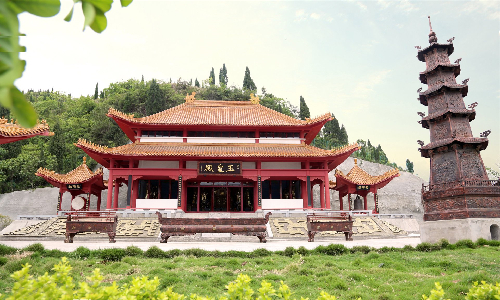
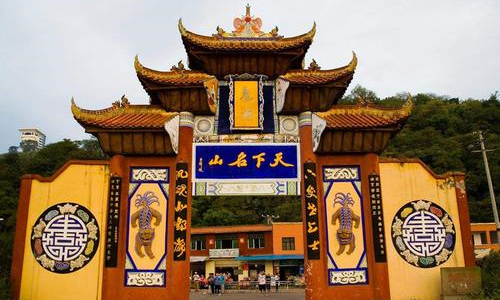
Today, your ship will sail through the Three Gorges: Qutang Gorge, Wu Gorge, and Xiling Gorge.
In the morning, you can first have an optional shore excursion to White Emperor City. Note that an extra fee is needed. Suited at the entrance of the Qutang Gorge, the White Emperor City boasts an ancient fortress and a temple complex on a hill, atop which you can enjoy a picturesque view that’s printed on the 10-yuan RMB banknote. According to a local legend, this White Emperor City is named so because there was one day, a white mist shaped like a dragon rose from a local well. The dragon symbolizes the emperor, so the ruler of this place then called himself White Emperor and gave the city such a name. The city has always been favored by ancient Chinese poets like Li Bai and Du Fu and they wrote some poems about it, wining the name of “City of Poems” for it.
Then your ship will sail through Quangtang Gorge. Except for an eyes’ feast of landscape, you may hear the cries of monkeys along your way. Then your ship will sail through Wu Gorge, the most beautiful gorge among the Three Gorges. This gorge is covered with clouds and mist all year round. It rains very often here, and when it rains, the famous scene of “Mountains Covered by Mists in Wu Gorge” is formed.
In the afternoon you will shift to a small boat to visit Goddess Stream. As its name shows, the Goddess Stream is a place as beautiful as the goddess, and thus getting the name of Goddess Stream by the locals. With a total length of 30 kilometers, the Goddess Stream is one of the most amazing streams in the world. It is a primitive virgin place with few traces of people, and the legend says that the Seven Fairy Maidens (fairies from the Heaven according to legends) used to bathe here.
Then in the late afternoon, your ship will sail through Xiling Gorge. Xiling Gorge is the longest one among the Three Gorges, with a length of 76 kilometers. It is famous for its winding waterways, strange rocks, and numerous shoals. A captain’s farewell banquet is prepared in the evening for you.
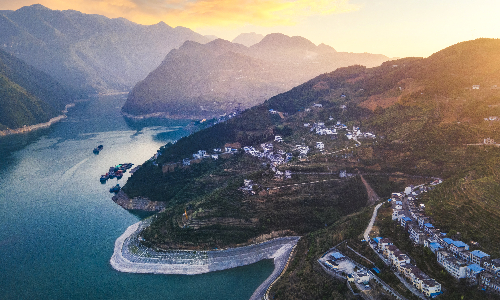
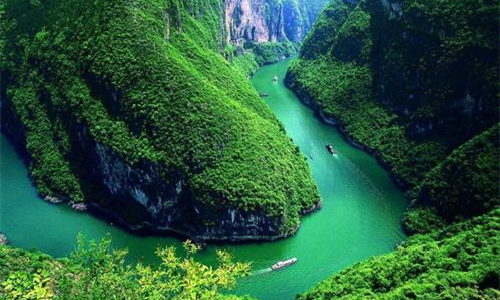
 Yichang
Yichang Shanghai
Shanghai After breakfast, we will have a shore excursion to the Three Gorges Dam Site. With 600 kilometers in length and 175 meters above the river, the Three Gorges Dam Site is the world’s largest hydroelectric project. Like a giant door, the dam locks the exit of the Three Gorges of the Yangtze River to generate electricity and control flooding. To get a better knowledge and deeper insight into the Three Gorges Dam Site, you are recommended to experience the world’s largest ship lift. Kindly note that this ship lift experience requires an extra charge on site. At noon, a shuttle bus will take you to Yichang Three Gorges Center Cruise Terminal, and our guide will pick you up there to take the estimated train D354 14:46/22:21 to the hotel in Shanghai. Upon arrival, your guide in Shanghai will transfer you to your hotel.
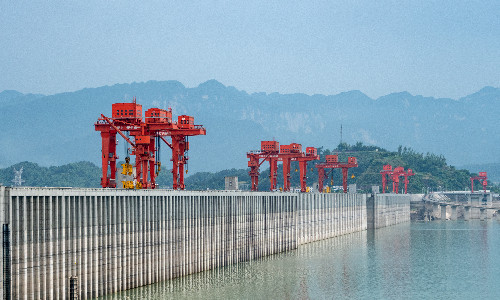
After breakfast, we will first take you to the Jade Buddha Temple. According to the name of the temple, you can guess it features jade Buddha statues. The two jade Buddha statues enshrined in the temple were brought back from Myanmar by Monk Huigen (an eminent monk in the Tang Dynasty). One of them is a 1.95-meters-tall sitting Buddha, and the other is a smaller reclining one. Established in 1882, the temple has been favored by locals and foreign guests.
Another hot and time-honored spot we are going to visit is Yu Garden (closed each Monday). Constructed firstly in 1559 by Pan Yunduan, Yu Garden is a classical Chinese garden orginally built for his family. A highlight in the garden is the Exquisite Jade Rock, which is a giant rock reaching 4 meters high and riddled with 72 holes. Legend has it that the rock was originally owned by an emperor of the Song Dynasty (960-1279), but it is Pan that finally got the rock. For its elegant and interesting facade, the Exquisite Jade Rock is perhaps the most famous rock in Shanghai and is known as one of three peculiar-looking stones of areas in the south of the Yangtze River.
After lunch, you will appreciate the modern side of Shanghai. Shanghai Oriental Pearl TV Tower is iconic of the prosperous city. With 468 meters, it boasts a fantastic view of the Shanghai skyline. It is not simply a TV tower, but also includes observation decks, a hotel, a revolving restaurant, and so on. Its highest observation deck reaches a height of 351 meters. What’s more, there will be thousands of participants who climb the stairs of the tower in a competition every year.
The next destination is the Bund. Running along the western bank of the Huangpu River, the Bund is a world renowned place to admire the various types of architecture. It boasts 52 buildings with various architectural styles such as the styles of Eclecticist, Romanesque Revival, and Gothic Revival, symbolizing one of the most impressive urban views in Asia.
Nanjing Road will be our last stop in Shanghai. Nanjing Road is a hot shopping street lined with stores on its two sides. From the modern malls to the historical stores, you could buy just about everything you want here. The Dang Dang Car in the street looks like a miniature version of the old tram. As one of the busiest streets in the world, the area serves not only as a shopping paradise but also a paradise for foodies, gathering lots of time-honored restaurants. After some free time, we will pick you up and send you to the hotel.
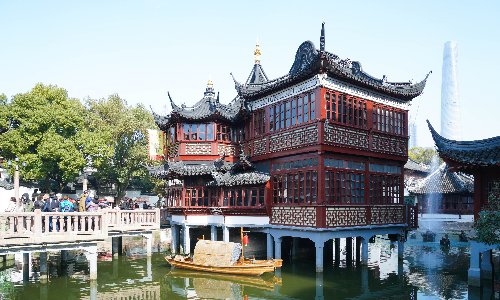
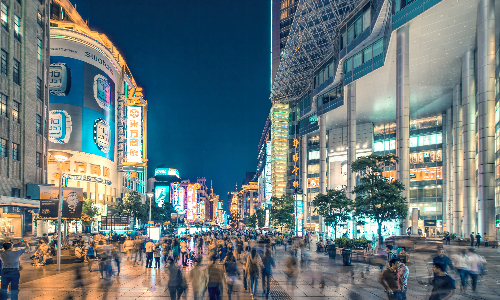
It’s time to say goodbye. After breakfast, our guide will send you to the airport and help you with check-in procedures. Looking forward to our next meeting!
Author: Chen Siqi
Proofreader: Li Yiwen
| City | Five Star hotel list | Four Star hotel list |
|---|---|---|
| Beijing | Sunworld Dynasty Hotel Beijing Wangfujing | Sunworld Hotel Wangfujing |
| Xi'an | Tianyu Gloria Grand Hotel Xi'an | Sunworld Dynasty Hotel |
| Yangtze River Cruise | Victoria Anna | Victoria Anna |
| Shanghai | Ocean Hotel Shanghai | Ambassador Hotel |
 |
![]() About your child or infant, please contact us for a discounted price.
About your child or infant, please contact us for a discounted price.



We started with a few days in Beijing & ended in Shanghai, from where we visited the Forbidden City and Great Wall. In between we visited Terra Cotta Warriors Museum, Panda Base, Shanghai Disneyland.

We had a wonderful holiday in China which will remain long in the memory. China is a breathtakingly beautiful country full of splendid temples and palaces, mountains and rivers, peaceful rural scenes and bustling shopping streets.
 QUICK ENQUIRY
QUICK ENQUIRY